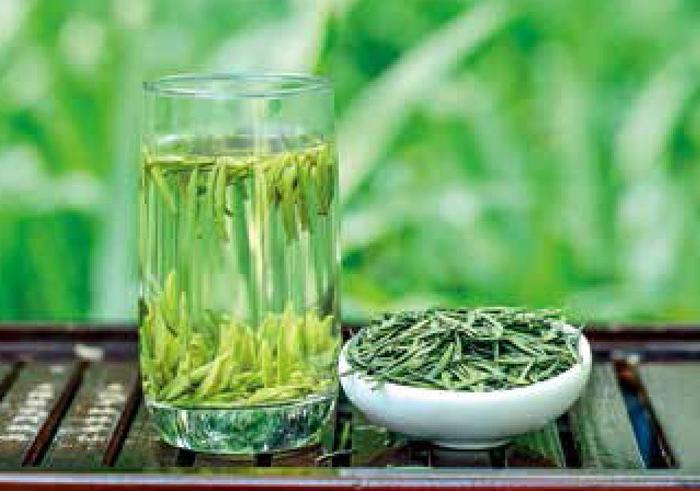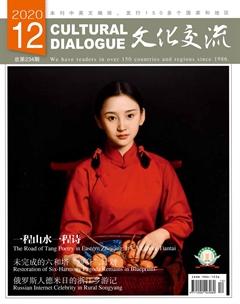江南茶源润韩日
周琦



天台山不仅是江南最早的茶叶栽培地之一,中国茶道思想的发源地,也是中国与朝鲜半岛、日本佛茶交流传播的圣地,流传佛教丛林的“罗汉供茶”就发祥于天台山寺院。
道家视茶为仙药
天台山的茶文化博大精深、源远流长。早在《山海经·大荒南经》中就有关于天台山的记载。到了东汉末年,江南道教创始人葛玄,入天台赤城山、华顶山,临海括苍山、盖竹山和宁海丹丘等名山炼丹修道,“植茶之圃已上华顶”,距今已有1800多年的历史。至今天台华顶山葛仙茗圃、临海盖竹山葛仙茗园尚存,成为公认的江南茶叶最早栽培地之一。
茶自古以来被视为能解百毒的仙药,《本草》云:“神农尝百草,一日而遇七十毒,得茶以解之。今人服药不饮茶,恐解药也”(《格致镜原》卷二十一引,四库本,下同)。《淮南子》云:“神农尝百草之滋味,一日而七十毒,由是医方兴焉。”(《重修正和政类本草》卷一引)《本草经》,即《神农本草经》,是中国现存最早的药物学专著。因此《神农本草经》对茶的解释,古往今来一直被视为经典。
中国道教更是视茶为“能生羽翼”的仙药。“丹邱”是天台山或台州的别称。东晋著名文学家孙绰在《天台山赋》中说,“仍羽人于丹邱,寻不死之福庭。苟台岭之可攀,亦何羡于层城?”唐代诗僧皎然《饮茶歌送郑容》诗云:“丹丘羽人轻玉食,采茶饮之生羽翼。”诗自注:“《天台记》云:丹丘出大茗,服之生羽翼。”元代诗人陈基在《小丹丘记》中指出:“昔孙兴公赋天台有曰:‘仍羽人于丹丘,为天台之别称。”(《台学统》卷65引)可见,“丹邱”与“天台”已是水乳交融、浑然一体。
皎然的茶道思想
关于茶道的书有许多。
据《中国茶叶大辞典》载:“茶道是以吃茶为契机的综合性文化活动。茶道之‘道,有多种含义:一是宇宙万物的本原、本体;二指事理的规律和准则;三指技艺与技术。中唐诗僧皎然的《饮茶歌诮崔石使君》首现‘茶道二字:‘三饮便得道,何须苦心破烦恼;‘孰知茶道全尔真,唯有丹丘得如此。”中国台湾学者吴静宜在《天台宗与茶禅的关系》一文中指出:“中国‘茶道一词,最早见于皎然《饮茶歌诮崔石使君》诗。”
皎然(730~799年),俗姓谢,字清昼,湖州(浙江吴兴)人,是中国山水诗创始人谢灵运的十世孙。皎然《饮茶歌诮崔石使君》诗云:“越人遗我剡溪茗,采得金牙爨金鼎。素瓷雪色缥沫香,何似諸仙琼蕊浆。一饮涤昏寐,情来朗爽满天地。再饮清我神,忽如飞雨洒轻尘。三饮便得道,何须苦心破烦恼。此物清高世莫知,世人饮酒多自欺。愁看毕卓瓮间夜,笑向陶潜篱下时。崔侯啜之意不已,狂歌一曲惊人耳。孰知茶道全尔真,唯有丹丘得如此。”其实皎然茶道“三饮”与“孰知茶道全尔真,唯有丹丘得如此”的茶道境界,正是源于天台宗智者大师“一色一香,无非中道”思想。智者大师在《摩诃止观》卷一上《圆顿章》中提出了“一色一香,无非中道,己界及佛界,众生界亦然”的著名命题,意谓中道实相之理,遍布于一色一香等一切微细之物中。这既开启了天台宗第九祖湛然提倡“佛法平等、无情有性”之说的先河,又成为“青青翠竹,尽是法身;郁郁黄花,无非般若”这一南宗顿悟禅的主要源头。所以吴静宜在《天台宗与茶禅的关系》一文中说:“自天台宗在天台山发展之后,中国茶道遂逐渐转为茶禅。”
“茶禅一味”的策源地
从唐代茶诗看,茶禅一味滥觞于中唐。皎然与陆羽虽是至交,但对《茶经》只谈“祛疾”不谈茶道表示不满。皎然《杼山集》卷七《饮茶歌送郑容》诗云:“云山童子调金铛,楚人《茶经》虚得名。霜天半夜芳草折,烂漫缃花啜又生。常说此茶祛我疾,使人胸中荡忧栗。”皎然与郑容两人饮茶论道,说茶主要的功效不在于祛除疾病,而是荡除胸中忧愁与烦恼,并指出《茶经》“即色不悟空”的不足之处。陆羽着重茶艺,皎然认为应将饮茶提升至茶禅的境界。皎然《对陆迅饮天目山茶因寄元居士晟》诗云:“喜见幽人会,初开野客茶……投铛涌作沫,着碗聚生花。稍与禅经近,聊将睡网余……”将茶比拟为“禅经”,以为茶与禅经相近。
最早提及“茶禅一味”的是南宋台州判官陈知柔。陈知柔《题石桥》诗云:“巨石横空岂偶然,万雷奔壑有飞泉。好山雄压三千界,幽处长栖五百仙。云际楼台深夜见,雨中钟鼓隔溪传。我来不作声闻想,聊试茶瓯一味禅。”(宋林表民编《天台续集·别编》卷二中)诗中不仅描绘了雄伟壮丽的天台石桥作为中日佛茶“罗汉供茶”发祥地的胜景,而且还首次点出了“茶禅一味”这一茶道最高境界。
宋人高似孙《国清寺泉时有绿蟾蹲崖石西》诗略云:“……山僧惜一茶,自碾仍自煮。相从有觉意,两悟无凡语。欲分鲜花屏,稍筑松风庑。铜瓶取明月,洗此文字苦。”(宋林表民编《天台续集·别编》卷四)说明宋代天台山国清寺僧人在自制、自碾、自煮茶的过程中,能领悟禅法,超越文字,进入无我的“茶禅一味”境界。
“罗汉供茶”的故事
茶禅一味与中国天台山特有的佛茶艺术“罗汉供茶”是和合共生。从皎然《饮茶歌诮崔石使君》“素瓷雪色缥沫香,何似诸仙琼蕊浆”的诗句看,“罗汉供茶”的乳花应产生于中唐。“素瓷雪色缥沫香”,即茶瓯中飘起的白色乳花。这是唐代陆羽在《茶经》里记载的一种煎茶法。陆羽《茶经·五之出》载:“(茶之)沫饽,汤之华也。华之薄者曰沫,厚之者曰饽,细轻者曰花。如枣花漂漂然于环池之上,又如回潭曲渚青萍之始生,又如晴天爽朗有浮云鳞然。”
最早将天台山石梁确立为中国五百罗汉根本道场的,是晚唐百丈怀海禅师。百丈怀海(749~814年)禅师在《百丈清规》中不仅确立了天台山石梁是中国五百罗汉栖真之地,还制定一套供养罗汉的仪轨,使之在中国佛教界产生了巨大的影响。(唐陈翊《唐洪州百丈山故怀海禅师塔铭》)这一清规在佛教界推行后,天下丛林纷纷仿效,很快风行于全国。
天台山方广寺的“罗汉供茶”不仅在当时的宋朝廷里引起轰动,还影响到东邻日本。
日本最早记载“罗汉供茶”的是日本佛教天台宗大云寺主成寻(1011—1081年)的《参天台五台山记》:“熙宁五年(1072年)五月十九日戊戌辰时参石桥,以茶供罗汉五百十六杯,以铃杵真言供养。知事僧惊来告:茶八叶莲花纹,五百余杯有花纹。知事僧合掌礼拜,小僧(指成寻)实知罗汉出现受大师茶供,现灵瑞也。”经葛宏、成寻等人宣扬,石桥“罗汉供茶”名驰中外,天台山石桥遂成为中外品茗观瀑之胜地。
天台茶种传日本、高丽
天台山的万年讲寺、国清讲寺,都是日本僧侣到中国来参访时最先上岸參拜的地方。如今,日本茶道文化,在日本独树一帜,代表着日本传统文化的结晶。
早在中唐,天台山云雾茶就传播东亚。唐贞元二十年(804年),日本天台宗创始人最澄入唐求法至天台山国清寺,师从道邃和行满,次年回国时,带去天台山茶叶与茶籽,种在近江(滋贺县)比睿山东麓日吉神社的旁边,成为日本最古老的茶园。日吉神社附近的池上茶园内,至今还矗立着一块高大的《日吉茶园之碑》,记载了最澄在天台山携回茶种辟园种植的历史,这是在日本最早的关于中国茶种传往国外的文献记载。
日本茶道的源头是荣西禅师,他曾经两度在宋代前来求法,前往万年讲寺求得茶籽、茶树带回日本,使得日本的茶文化得以传播。
南宋淳熙十四年(1187年),日本荣西禅师第二次来华至天台山万年寺师事万年寺虚庵怀敝,留居两年5个月。其间,荣西深入万年山、石梁一带茶区,了解种茶、制茶技术和煮茶泡茶方法、茶道文化及其功效。绍熙二年(1191年)荣西回国时,带去大量天台山茶种,一路将茶籽分种于平户、肥前、博多等地,荣西还将茶籽送给京都栂尾高山寺明惠上人,明惠将其种植在寺旁。日本建久三年,荣西用汉文写就被誉为日本“茶经”的《吃茶养生记》一书,大力提倡饮茶养生,被后人誉为日本“茶圣”,并奠定了现今的日本茶道。今日本平户市木引街富春庵旁立有“荣西禅师遗迹之茶园”,京都拇尾高山寺立有“日本最古之茶园”碑。
道元(1200~1253年),俗姓源,号希玄,京都人。14岁登日本天台宗总本山比睿山。从天台座主公圆出家,遍学天台教义。1214年到建仁寺谒荣西,习临济宗。荣西寂后,师事明全。1223年与明全入宋求法,历游江南名刹。1225年春夏之交,26岁的道元来到天台山万年寺,从元鼒住持受法。后师事宁波天童寺长翁如净,随侍3年,1227年回国,于越前(今福井县)开创永平寺,成为日本曹洞宗的总本山。道元回国后,把天台山石梁“罗汉供茶”也移植到日本曹洞宗总本山永平寺。
据《十六罗汉现瑞华记》载:日本宝治三年(1249年)正月初一,道元在永平寺以茶供养十六罗汉。午时,十六尊木像和绘像罗汉皆现瑞华。其记又云:“现瑞华之例仅大宋国台州天台山石梁而已,本山未尝听说。今日本山数现瑞华,实是大吉样也。”为此,道元亲撰《图汉供养式文》,记述了这一“灵异事迹”。其中谈到荣西两次在天台山看到“罗汉供茶”的“灵异事迹”:一次在石梁,一次在万年寺。
如今,日本许多寺院内还保留着“罗汉供茶”的仪式。1983年4月16日至17日,日本长野县中野市栗和田常乐寺开创400周年举行法会,就有“罗汉供茶”的仪式。
《三国史记》是一部记述朝鲜半岛三国新罗、百济、高句丽历史的高丽官修正史,于高丽仁宗二十三年(1145年)由金富轼等以文言文编撰。其中记载:新罗兴德王三年(828年),唐文宗召见遣唐使金大廉于麟德殿,并赠予天台山茶种籽,金大廉带回茶种籽,始植于韩国全罗南道地理山(今智异山),其地立有“茶始培地”之碑。1999年,浙江大学茶学系韩国留学生李恩京以《中国天台山和韩国智异山茶树比较形态学的研究》为题,经3年研究,最后得出韩国智异山茶树源于天台山的结论。
宋元丰时期,高丽天台宗创始人义天曾担任高丽使者前来宋朝朝贡,并至天台国清寺参诸耆宿,从天竺寺慈辨诣天台教观,对天台宗教义领悟深刻,并将茶种籽、天台禅法与茶仪传回韩国。可见由天台茶禅所产生的影响,已经扩大到日韩等东亚邻国。
文化学者孙明霞曾撰文说,日本茶道是中日文化交流结出的硕果。日本茶文化吸收了中国“茶禅一味”的精神内核,发展出了自己的“和、敬、清、寂”的茶道精神,成为融宗教、哲学、伦理、美学为一体的文化艺术活动。源于中国的日本茶道,在日本发展成了完备的体系,得到了发扬光大。近年来,中国大陆茶人多有赴日访古,茶界一直流行着“日本回流器皿”,以质优物美著称。
中日茶道的互相影响,使得茶道的传统得以绵延继续。前些年,中国天台山华顶讲寺举行“禅茶雅集”活动。来自日本、韩国、中国(包括中国台湾)的禅茶界代表,齐聚天台山品茗论道、体验交流,认知“禅即茶、茶即禅”圆融不二关系,感受“江南茶祖、韩日茶源”天台山云雾茶智慧之芽的魅力。
Mount Tiantai is one of the earliest tea growers in Chinas Jiangnan regions and is the birthplace of the Chinese tea ceremony. It is also the seedbed of the “Buddha tea” communication between China and the Korean Peninsula and Japan. The “Arhat Tea” was born in the temples of Tiantai.
Tea is one of the many things Mt. Tiantai takes pride in. The regions tea culture is recorded in , written in the Warring States period (403-221 BC) of China. The regions tea history is glorified by Ge Xuan, the founder of the Jiangnan Taoism, who practiced alchemy in the mountains in Tiantai and Linhai about 1,800 years ago. Today, the mans heritage can be tasted in two tea gardens in Tiantai and Linhai.
Tea has been considered an all-purpose remedy in the Chinese culture, and is valued as an elixir that “can add wings to humans” by Taoists. In the old times, Mount Tiantai or Taizhou was often referred to as “Danqiu” (a mountain where deities dwell). The connection between “Danqiu” and tea and stories about winged immortals can be found in ancient literature.
Taiwanese scholar Wu Jingyi points out in her writings that the Chinese tea ceremony and philosophy was first mentioned in a poem by Jiaoran (730-799), a monk poet in the Tang Dynasty.
The monks secular name is Xie Qingzou. Born in Wuxing, in present-day Huzhou, he is the 10th-generation descendant of Xie Lingyun (385-422), widely recognized as the founder of Chinas “landscape poetry”.
In one of his poems, Jiaoran made the verdict that “it takes only three sips of tea to reach the ultimate truth” and that “the revelation can only be realized in Danqiu”. What was announced by Jiaoran as the “magic power to reach the ultimate truth” is derived from the thoughts of Zhizhe, a master monk based in Tiantai. The monk preached in a book of Buddhism that the truth was everything and everywhere, laying the cornerstone of the Tiantai sect of Buddhism that has enjoyed a hard-core following since it was born not only in China but also in Japan and the Korean Peninsula.
Jiaoran and Lu Yu (733-804) were good friends, but the former complained that the by the latter focused too much on the medical functions of tea. A firm believer in the connection between tea and Zen, Jiaoran insisted that the nature of tea be more cultural and spiritual, and that the book of his friend enjoyed an undeserved reputation.
The theory about tea and Zen in one was first proposed by Chen Zhirou, a judge based in Taizhou in the Southern Song Dynasty (1127-1279). In one of his poems, he depicted the scenic splendor of a stone bridge in Tiantai serving as the birthplace of the “Arhat tea”. How the monks at the Guoqing Temple in Tiantai reached their revelation through their daily tea practices can be seen from a poem written by Gao Sisun of the Song Dynasty when he was visiting the temple.
The tea and Zen two-in-one theory was closely related to the tradition of Arhat tea in Tiantai. The ceremony of Arhat tea practiced by monks at the Fangguang Temple in the depths of Mount Tiantai was not only sensational in the Song royal court, but had far-reaching influences on the tea culture of Japan. The long-time tea communication between Tiantai and Japan explains the fact that the Wannian Temple and the Guoqing Temple in Tiantai are the first worshipping places of visiting Japanese monks.
The fame of the Mist Tea, grown in Mt. Tiantai, reached the entire East Asia in the heyday of the Tang Dynasty. In the year 804, Monk Saicho (767-822), founder of Japans Tiantai Buddhism sect, arrived at the Guoqing Temple to learn from the master monk there. The next year he returned to Japan with some tea leaves and seeds that eventually gave rise to Japans oldest tea garden, seated in Shiga Prefecture in central Japan.
Monk Eisai, widely recognized as the founder of Japanese Sado (Way of Tea), visited Tiantai twice in the Song times, and returned to Japan also with tea trees and seeds. His second visit lasted nearly 2.5 years, and became a significant experience of tea cultural immersion. His book about tea, written in Chinese and regarded as the Japanese version of , laid the foundation of modern Japanese Sado.
The fragrance of the Tiantai-born Arhat Tea can still be tasted at many temples in Japan today, with the ceremony practiced in many ceremonial events.
The research of a Korean student who spent three years in the Tea Culture Department of Zhejiang University led to the conclusion about the origin of Jirisan tea trees in South Korea. In the Yuanfeng period of the Song, the founder of the Tiantai Buddhism sect in Korea visited Guoqing Temple in Tiantai, and brought back tea seeds to Korea where he also shared what he learned about the tea ceremony practiced in Tiantai.
Sun Mingxia, a cultural scholar, pointed out that the tea culture of Tiantai blossomed into a self-contained system in Japan, where the “seeds” are nourished by religion, philosophy, ethics and aesthetics and produced a new, enduring culture that forever inspires.
In 2013, a tea culture seminar held at the Huading Temple in Tiantai, drawing representatives from China, Japan and South Korea, showed to the world how a piece of leave brought three cultures together and heals the hearts of all.

